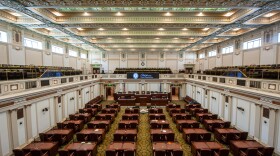Marcela Loría-Salazar studies aerosols as an assistant professor at OU — not just smoke, but also airborne dust and pollutants.
Loría-Salazar's lab is working to answer questions about how aerosols affect severe weather forecasting and how smoke moves as wind moves it away from a fire. She's been working with individuals and tribes to set up air quality monitoring stations across Oklahoma and New Mexico.
Right now, there are large swaths of Oklahoma that don't have any air quality monitoring stations at all. If someone from Buffalo, Oklahoma, looks at PurpleAir's map of air quality measured by a network of privately owned monitoring stations, they'd need to rely on data from stations more than 100 miles away in Guymon or Burns Flat.
"They are telling you that the air quality is good there, but it's not necessarily good air quality," Loría-Salazar said. "It is that there is nothing to measure there."

When Loría-Salazar started studying wildfire smoke in 2010, wildfires weren't as much of a problem as they are today. But in the last two decades, the frequency of extreme wildfires has more than doubled worldwide.
"So then everybody started studying in a very chaotic way, because it was a problem that just exploded in our face," she said. "Like, oh, we need information."
Now, the National Academies of Science, Engineering and Medicine has created a committee to shape wildfire smoke research in the U.S. Loría-Salazar will be one of fourteen researchers to serve on the panel.
"We need to create ways to understand what has been done in the last 15 years from the science community — what is useful and what is not useful," she said. "What are the gaps that we need to fill? And the things that we need to create to overcome these issues now."
Loría-Salazar will work with the committee for 12-18 months, and the results will be presented to Congress.
Copyright 2025 KOSU







